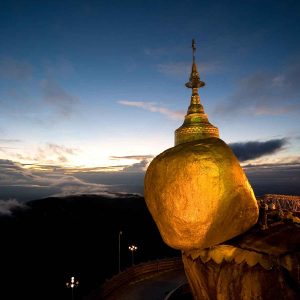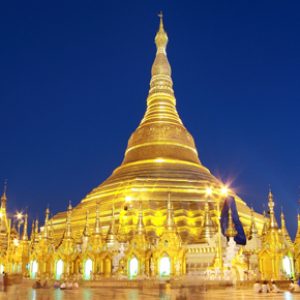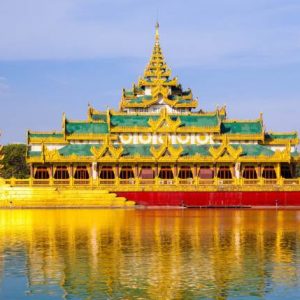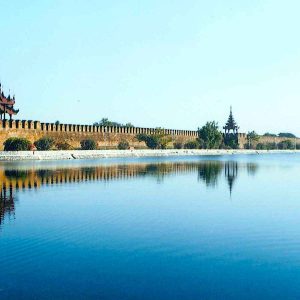Myanmar
| 04th January | Independence Day |
| 12th February | Union Day |
| 02nd March | Peasants’ Day |
| 26th March | Full Moon of Tabaung |
| 27th March | Armed Forces Day |
| 13th-16th April | Maha Thingyan (Water Festival). |
| 17th April | Myanmar New Year |
| 01st May | Labour Day |
| 25th May | Full Moon of Kason (Buddha’s Birthday). |
| 19th July | Martyrs’ Day. |
| 22th July | Full moon of Waso (Beginning of Buddhism lent). |
| 21th October | Full Moon of Thadingyut (End of Buddhist Lent). |
| 18th November | Full Moon of Tazaungmone |
| 08th December | National day |
| 25th December | Christmas Day.have their defenders; we at Interknowledge leave the decision to you. |
Over 80 percent of Myanmar embraces are Theravada Buddhism. There are Christians, Muslims, Hindus and some animists.
Culture
Myanmar lies on the crossroad of two of the world’s great civilizations – China and India – but its culture is neither that of India nor that of China exclusively, but a blend of both interspersed with Myanmar native traits and characteristics. Buddhism has great influence on daily life of the Myanmar. The people have preserved the traditions of close family ties, respect for the elders, reverence for Buddhism and simple native dress. Myanmars are contented and cheerful even in the face of adversities and known for their simple hospitality and friendliness.
| Australia | 88, Strand Road, Kytauktada Tsp, Yangon. Ph; 951-251810, 251797, 251798, 251809, 246462, 246463 Fax; 951-246159 |
| Bangladesh | 11(B), Than Lwin Road, Bahan Tsp, Yangon. Ph; 951-515275, 526144 Fax; 951-515273 Email; bdootygn@mptmail.net.mm |
| Brunei Darussalam | 371/319, U Wisara Road, Sanchaung Tsp, Yangon. Ph; 951-526985, 524285 Fax; 951-512854 Email; bruneiemb@bruneiemb.com.mm |
| Cambodia | 25(3B/4B), New University Avenue Road, Bahan Tsp, Yangon. Ph; 951-549609, 540964 Fax; 951-512854 Email; recyangon@myanmar.com.mm |
| China | 1, Pyidaungsu Yeiktha Road, Dagon Tsp, Yangon. Ph; 951-221280, 221281, 224025, 224097, 221926 Fax; 951-227019, 228319 |
| Egypt | 81, Pyidaungsu Yeiktha Road, Dagon Tsp, Yangon.. Ph; 951-222886, 222887 Fax; 951-222865 Email; egyembyangon@mptmail.net.mm |
| France | 102, Pyidaungsu Yeiktha Road, Dagon Tsp, Yangon. Ph; 951-212178, 212520, 212523, 212528, 512532 Fax; 951-212527 Email; ambafrance.rangoun@diplomatie.fr |
| Germany | 9, Bogyoke Aung San Museum Street, Bahan Tsp, Yangon. Ph; 951-548951, 548952, 548953 Fax; 951-548899 Email; info@rangun.diplo.de |
| India | 545-547, Merchant Street, Kyauktada Tsp, Yangon. Ph; 951-391219, 388412, 243972 Fax; 951-254086, 250164, 388414 Email; indiaembassy@mptmail.net.mm |
| Indonesia | 100, Pyidaungsu Yeiktha Road, Dagon Tsp, Yangon. Ph; 951-254465, 254469, 229750 Fax; 951-254468 Email; yangon.kbri@deplu.go.id |
| Israel | 15, Khabaung Street, Hlaing Tsp, Yangon. Ph; 951-515115 Fax; 951-515116 Email; info@yangon.mfa.gov.il |
| Italy | 3, Inya Myaing Road, Golden Valley, Bahan Tsp, Yangon. Ph; 951-527100, 527101 Fax; 951-514565 Email; ambyang.mail@esteri.it |
| Japan | 100, Natmauk Road, Bahan Tsp, Yangon Ph; 951-549644-8, 540411, 540400, 540399, 545988 Fax; 951-549643 |
| North Korea | 77C, Shin Saw Pu Road, Sanchaung Tsp, Yangon. Ph; 951-512642, 510205 Fax; 951-510206 |
| South Korea | 97, University Avenue, Bahan Tsp, Yangon. Ph; 951-527142, 527143, 527144, 515190 Fax; 951-513286 Email; hankuk@koremby.net.mm |
| Laos | A-1, Diplomatic Quarters, Taw Win Street, Dagon Tsp, Yangon. Ph; 951-222482 Fax; 951-227446 Email; laoembcab@mptmail.net.mm |
| Malaysia | 82, Pyidaungsu Yeiktha Road, Dagon Tsp, Yangon. Ph; 951-220248, 220249, 220251, 220230 Fax; 951-221840 Email; mwkyangon@mptmail.net.mm |
| Nepal | 16, Natmauk Yeiktha Lane, Tamwe Tsp, Yangon. Ph; 951-545880, 557168 Fax; 951-549803 Email; nepemb@mptmail.net.mm |
| Pakistan | A-4, Diplomatic Quarters, Pyay Road, Dagon Tsp, Yangon. Ph; 951-222881 Fax; 951-221147 Email; pakistan@myanmar.com.mm |
| Philippines | 50, Saya San Road, Bahan Tsp, Yangon. Ph; 951-558149, 558150, 558151 Fax; 951-558154 Email; yangonpe@mptmail.net.mm |
| Russian | 38, Sagawa Road, Dagon Tsp, Yangon. Ph; 951-241955, 254161 Fax; 951-241953 Email; rusinmyan@mptmail.net.mm |
| Saudi Arabia | 287/289, U Wisara Road, Sanchaung Tsp, Yangon. Ph; 951-536153, 516952 Fax; 951-516951 |
| Serbia | 114-A, Inya Road, Kamaryut Tsp, Yangon. Ph; 951-515282, 515283 Fax; 951-504274 Email; serbemb@yangon.net.mm |
| Singapore | 238, Dhamazedi Road, Bahan Tsp, Yangon. Ph; 951-559001 Fax; 951-559002, 559922 Email; singemb_ygn@mfa.gov.sg |
| Sri Lanka | 34, Taw Win Street, Dagon Tsp, Yangon. Ph; 951-222812 Fax; 951-221509 Email; embsrilanka@yangon.net.mm |
| Thailand | 94, Pyay Road, Dagon Tsp, Yangon. Ph; 951-226721, 226728, 226824 Fax; 951-221713 Email; thaiygn@mfa.gov.th |
| United Kingdom | 80, Kan-na Road, Kyauktada Tsp, Yangon. Ph; 951-370867, 380322, 371852, 371853, 256438, 370863 Fax; 951-370866 Email; Visa.Rangoon@fco.gov.uk |
| United State of America | 110, University Avenue, Kamayut Tsp, Yangon. Ph; 951-536509, 535756 Fax; 951-650306 Email; consularrangoon@state.gov |
| Vietnam | 72, Than Lwin Road, Bahan Tsp, Yangon. Ph; 951-511305 Fax; 951-514897 Email; vnembmyr@cybertech.net.mm |
\r\n
\r\n
- The DO\’s\r\n
\r\n
\r\n
-
- Do Save Face
\r\n Koreans are very sensitive people and feelings, or face, are extremely important. Therefore, never insult or criticize people in front of others to avoid them losing face.\r\n
-
- Do have a business card ready
\r\n Business cards are exchanged after initial introductions with new partners. The way you treat someone\’s business card is indicative of the way you will treat the person so examine any card you recieve care fully and never write on someone\’s business card in that person\’s presence.\r\n
-
- Do developo realtionships
\r\n When doing business in Korea, endeavour to develop a respectful relationship with your Korean counterpart. Good relationships and informal agreements with a trusted counterpart are seen as far more secure than any legal contract. Don\’t use western logic when dealing with your new contacts – it won\’t translate. The first meeting with any potential partneris simply to ascertain whether he is trustworthy or not, so business isn\’t discussed.A low deep bow from Koreans following a business meeting means the meeting was successful, but a short, quick bow means it wasn\’t.\r\n
-
- Do come bearing gifts
\r\n Gift giving is and important part of Koean culture. Gifts express a great deal about a relationship. Because they are always reciprocated, it\’s best not to give expensive gifts, as this might be awkward for the recipient. Appropriate gifts when visiting someone\’s home is considered unlucky. Giving seven of an item is deemded lucky. Wrap gifts in red of yellow paper, since these are royal colours. Alternatively, yellow or pink paper denotes happiness. Don\’t wrap gifts in green, white of black paper.\r\n
-
- Do receive gifts corrctly
\r\n If you\’re on the receiving end, then refuse a couple of times first and then accept the gift – not accepting the gift would be offensive. Gifts aren\’t opened when first received but put aside and opened later.\r\n
-
- Do be after-dinner prepared
\r\n When leaving a gathering, thank your hosts graciously and bow ot each individual as a sign of respect. Expext to be walked out, as saying goodbye to guests inside is seen as insuling. After dinner. ths host my invite his guests to go drinking. Drinking competitions are common and it\’s expected that invitations will be accepted.\r\n
-
- Do go barefoot
\r\n Always remove your shoes when entering a Korean home. There are also some restaurants where you are supposed to enter with bare feet or with just socks.\r\n
-
- Do mind your hands
\r\n It is polite to pass or accept anythings, especially money, with your right hand while your left hand supports your forearm or wrist. It is usually polite to have money or items ready before transactions are made. To beckon someone, extend your arm palm down, and move your fingers in a scratching motion. It s rude to point with your index finger.\r\n
\r\n
\r\n
\r\n
- The DONT\’s\r\n
\r\n
\r\n
-
- Don\’t make a dash for the empty seat
\r\n It\’s best to be told where to sit when visiting South Korea, as there is often a strict protocol to be followed. The eldest are seated first and the most senior person begins the eating process at dinner. The seat of honour is the seat looking at the front door, and if you are seated there, it is polite to protext initially before taking your place.\r\n
-
- Don\’t leave half your meal
\r\n Table manners in South Korea dictate that you shouldn\’t leave anything on your plate. You can let people know that you\’ve eaten enough by keeping your chopsticks on the chopstick rest or on the table.\r\n
-
- Don\’t point with your chopsticks
\r\n It\’ll cause frowns and/or raised eyebrows. Don\’t leave your chopsticks sticking up in the rice bowl either, as this is reminiscent of funeral ritual.\r\n
-
- Don\’t hold a glass with one hand
\r\n It\’s the height of bad manners not to pick up a drink with both hands. Moreover, it\’s considered polite to pour each other drinks. If you refuse to pour a drink for someone, it will be seen as offensive. If you want ot refiil, then finish your drink. If you don\’t, leave some of your drinks in the glass.\r\n
-
- Don\’t turn up unannounced
\r\n Appointments are required for bussiness meetings and should be made three to four weeks in advance. It\’s rude to turn up unexpectedly at someone\’s place of work.\r\n
-
- Don\’t directly introduce yourself
\r\n Rather than introduce yourself to new acquaintances, wait to be introduced by somebody who knows both you and the person you would like to meet. Take this opportunity to ask ths person how he would like to be addressed, as only close friends or relatives will use names – Koreans will often call each other \”Teacher\”,\”Manager\”,\”President\”, etc. based on one\’s status. when multiple people have the same title, then it is followed by the person\’s three names.\r\n
-
- Don\’t forget to take a bow
\r\n Introductions in South Korea still start with a traditional bow and a firm handshake. The person who initiates the bow says,\”Man-na-suh pan-gop-sumnida,\” which means, \”Pleased to meet you.\”\r\n
-
- Don\’t blow your nose in public
\r\n It is perceived as vulgar.\r\n
\r\n
\r\n
The location and topography of the country generated a diversity of climate conditions. Seasonal changes in the monsoon wind directions create summer, rainy and winter seasons. Extremes of temperature are rare. The directions of winds and depression bring rain, and although it is always heavy in the coastal areas during monsoon season, it seldom creates hardships. The Government is giving priority to the forest conservation and greening of nine arid districts in central Myanmar.
There are three seasons, Summer is from March to May, Raining season is from June to October and Winter is from November to February.
It is a land of hills and valleys and is rimmed in the north, east and west by mountain ranges forming a giant horseshoe. Enclosed within the mountain barriers are the flat lands of Ayeyarwaddy, Chindwin and Sittaung River valleys where most of the country’s agricultural land and population are concentrated.
Ministry of Health has been implementing better health care management system and the international health regulation for the support of health tourism. There are points of entry health services at the international airports and passengers are requested to fill in the health declaration form.
Advices
- Stay away from narcotic drugs.
- Carry some medicines for diarrhea.
- If sick, don’t worry. All doctors are English literate.
- Health insurance is not available.
The Mons were not to be the only people in Mynamar for long. A few centuries later, the Pyu people arrived from Tibet, and they were followed by the Bamars who settled along the rich Irrawaddy river, which they controlled from Pagan. It was the Bamars who established the First Burmese Empire. Under King Anawrata, they conquered the Mon capital of Thaton and took a legendary 30,000 prisoners back to Pagan. The subtle appeal of the Buddhism the Mon practiced became a powerful conduit of their culture (a pattern seen in India as well) and Anawrata himself converted to Buddhism. The Bamars even adopted the Mon language. The Mons were not, apparently, very much appeased by these signs of cultural appreciation, as they later rebelled and killed Anawrata’s son. They were quickly crushed by Kyanzitta, a Bamar general who soon assumed rulership.
Kyanzitta’s rise marked the beginning of Burma’s golden age, when the bounty of rice irrigated by the Irrawady nourished civilization as it never had before. Thousands of temples were built, and the arts flourished. The kingdom’s health didn’t last long, however. Within a century, Kublai Khan appeared on the horizon, at the head of Mongol armies that were in their time the most powerful military forces on earth. The Khan’s demand for tribute was met with defiance by the Burmese King Narathihapate, and the Mongol invasion started to roll in. Ironically, it was not the ferocious Mongols who posed the greatest threat to Narathihapate: he was poisoned by his son, who later lost the kingdom to the Mongols in 1287 at the battle of Vochan. The Mons and the Bamar withdrew to the South, where they founded the enchanting city of Bago. In the North, descendants of the Tai people, called the Shan, founded a kingdom at Innwa. Soon the Mons and the Shan went to war, at almost exactly the time the Europeans started moving into Asia.
It was Nicoto di Conti, a Venetian, who was the first European to encounter Myanmar. Di Conti visited Bago in 1435 and stayed for four months. In 1498, the Portugeuse Vasco de Gama found a sea route to India, opening wide the path to Asia. Soon the Portugeuse had a colony in India at Goa, which they used as a base for eastern trade. De Gama’s countryman Anthony Correa made the first trade agreement in Myanmar with the viceroy of Martaban in 1519. The viceroy’s king, Tabinshweti, disapproved of the agreement, which was settled without his consent. Tabinshweti attacked Martaban in 1541, and, surprisingly, 700 Portuguese fought on his side. The Loyalist Portuguese retreated to Rahkine, another of the region’s kingdoms, and allied themselves with the monarch of Myohuang.
In 1600, a Portuguese cabin-boy named Philip de Brito y Nicote came to Myanmar, beginning one of the most legendary tales in Burma’s history. De Brito took a job with the king of Rahkine, who had by that time conquered Bago, and soon started constructing forts in the city. De Brito then took a trip to Goa, married the viceroy’s daughter, and returned to Bago with men and weapons. As a wedding present to himself, he conquered Myanmar, declared himself king, and set about destroying Buddhist temples. De Brito ruled for 13 years, until the locals finally laid siege to his fortress. After 34 days the bastion fell, and the foreign tyrant was coolly impaled on a wooden stake, his grueling execution lasting three days.
Despite the fall of De Brito’s personal kingdom, the European presence in Myanmar was there to stay, especially that of the British. Along the with French and Dutch, the British had colonies in Myanmar by the mid-17th century, although a Bamar king named Alaungpaya kicked out both the French and the British later in the century. Alaungpaya conquered Rahkine, extending his border all the way to the Bengal border, until the British Raj in nearby India decided that he had come too close for their comfort. The British invaded Burma in 1819, conquering Rahkine, Tanintharyi, Assam, and Manipur. In 1852, they extended their control to Lower Burma. By 1886, they had annexed the entire country as a province of India and ruled it through the Raj. As Asian independence movements began to cause problems for the British empire around the turn of the century, the British decided that it might be wise to grant some degree of autonomy in Burma. The symbolic gesture was unsurprisingly insufficient, and in 1930 a Burman named Saya San led a major armed rebellion against the British. The revolt was quashed and San executed, but the experience did inspire Britain to make Burma a separate colony. This slight rise in status was not enough, however, for Thakin Aung San, a student leader who spoke out eloquently for independence.
San was eventually arrested for his statements, but he escaped to China, where he collaborated with the Japanese. The Japanese made him promises of independence, provided he help them oust the British. In 1941, the Japanese and San did exactly that. In a legendary retreat, the British lost thousands of men, vowing to return. The allies were eventually able to take Burma back, but only after four years of incredibly arduous and deadly fighting. Aung San, who realized that the Japanese had their own imperialistic interests in his country, eventually sided with the allies.
The British granted independence to Burma in 1947, though they were worried that local fighting would erupt soon afterward. Aung San, who was ostensibly to have been the new leader, was assassinated the same year, and his colleague Thankin Nu became president. Thankin Nu stayed in power only briefly, asking General Ne Win to assume control as soon as the first signs of civil unrest erupted in 1958. Nu returned to power in 1960, partly because he promised the Mon and Rakhine semi-autonomy. Nu’s refusal to grant the same status to the Shan and the Kayins prompted another rebellion in 1962, and this time General Ne Win assumed control without waiting to be asked.
Ne Win, a radical communist, had Nu arrested and isolated the country, at the same time declaring the tatmadaw, or military government. After Nu was released in 1966, he fled the country and began to organize a rebellion. His forces managed to hold some land in 1971, but they were eventually thrown out. In 1981, Ne Win stepped down, granting amnesty to all political enemies. Nu returned home and died peacefully.
In 1988, a huge demonstration led by students resulted in a violent crackdown by the tatmadaw, who agreed to democratic elections in 1989. When the National League for Democracy (NLD) won 60 percent of the votes, however, the tatmadaw declared the elections invalid, as no agreement had been reached on the role of the new leaders. Since that time the military government has made repeated gestures toward democratic government, although they have in fact taken no real steps in that direction. The democracy movement’s current leader, Aung San Suu Kyi (the daughter of Aung San), was awarded the Nobel Peace Prize in 1991 while under house arrest. Suu Kyi continues to lead the movement today.
wordpress theme by initheme.com








